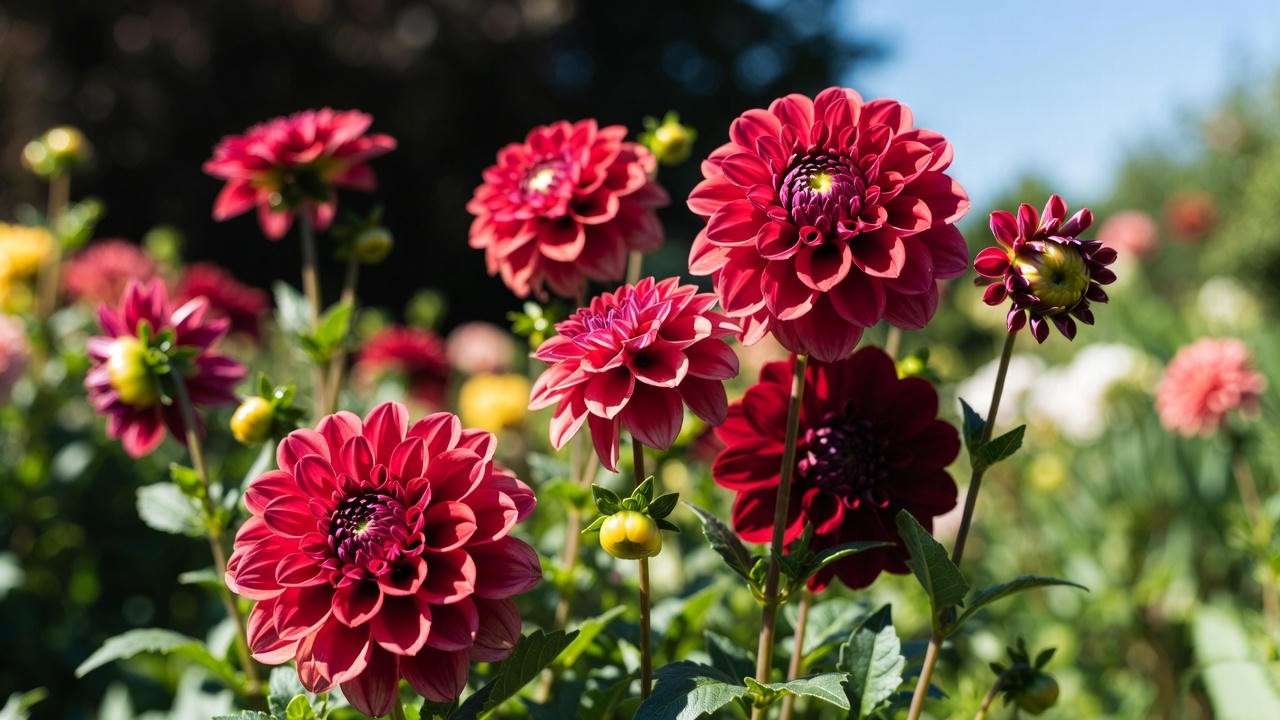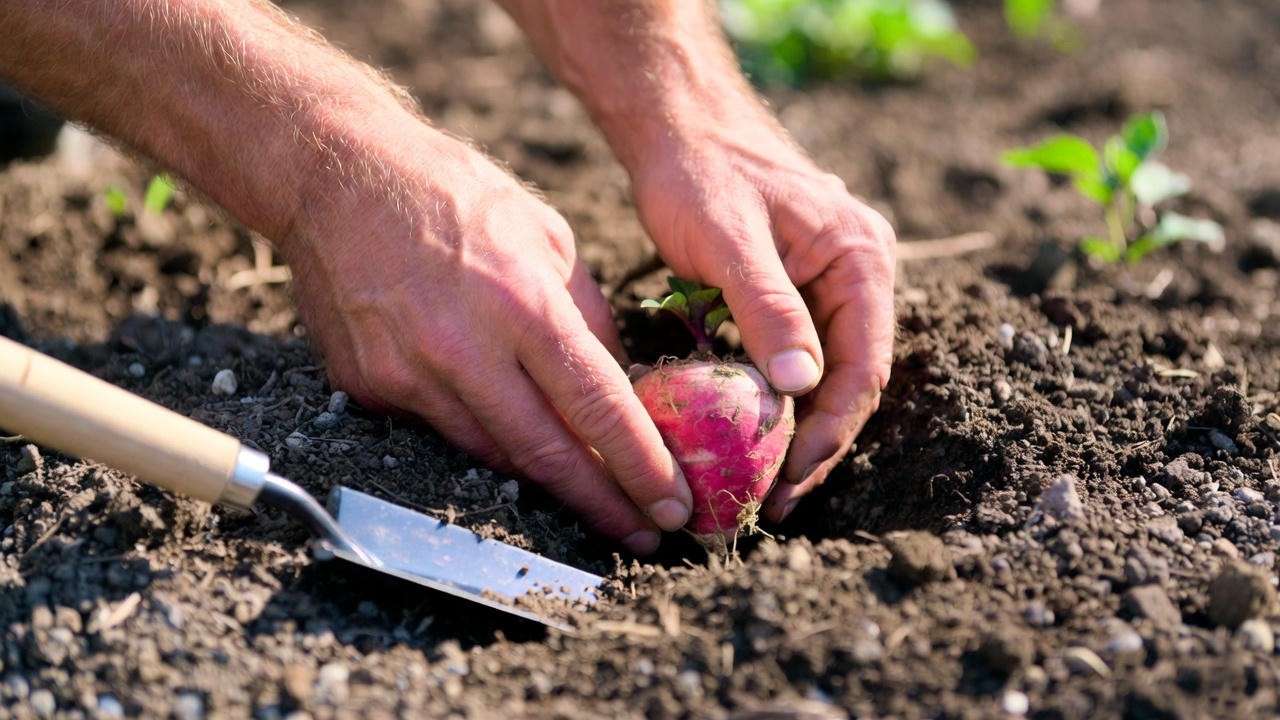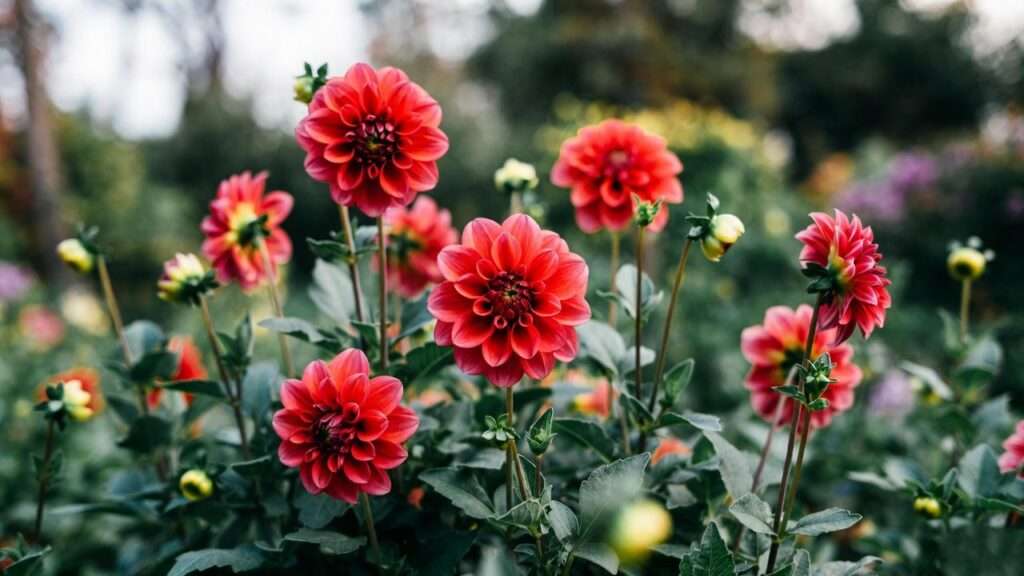Imagine stepping into your garden to be greeted by a sea of fiery red dahlia plants, their bold blooms stealing the show and turning heads. These stunning flowers, known for their vibrant hues and elegant forms, are a gardener’s dream — but only if you know their secrets. Red dahlia plants can transform any outdoor space into a masterpiece, yet they demand specific care to thrive. Whether you’re a beginner or a seasoned gardener, this guide reveals seven expert tips to ensure your red dahlias bloom vibrantly all season long. With over 15 years of horticultural expertise, I’ve cultivated countless dahlia varieties and am here to share proven strategies to help you succeed. From planting to pest control, let’s dive into everything you need to grow show-stopping red dahlias! 🌼
Why Choose Red Dahlia Plants? 🌷
The Allure of Red Dahlias
Red dahlia plants are the rock stars of the garden, offering bold, fiery blooms that demand attention. Varieties like ‘Bishop of Llandaff’ with its deep crimson petals and golden centers or ‘Arabian Night’ with its velvety, dark red flowers bring unmatched drama to any landscape. These flowers bloom from mid-summer to the first frost, providing months of color. Their versatility shines in garden beds, borders, or even containers, making them ideal for small patios or expansive yards. Growing red dahlias isn’t just about aesthetics — it’s about the pride of nurturing a plant that rewards you with breathtaking beauty.

Historical and Cultural Significance
Dahlias, including red varieties, trace their roots to Mexico, where they were first cultivated by the Aztecs. Named after Swedish botanist Anders Dahl, these flowers became a global sensation in the 19th century and remain a favorite today. As Mexico’s national flower, dahlias symbolize strength and elegance, adding a layer of cultural richness to your garden. This historical context isn’t just trivia — it underscores the timeless appeal of red dahlias and their enduring place in horticulture. 🌎
Understanding Red Dahlia Plant Needs 🌱
Ideal Growing Conditions
To unlock the full potential of your red dahlia plants, start with the right environment. These flowers thrive in full sun, requiring 6-8 hours of direct sunlight daily to produce their iconic blooms. Partial shade can lead to weak stems and fewer flowers, so choose a sunny spot. The soil should be fertile, well-draining, and slightly acidic to neutral (pH 6.0-7.0). If your soil is heavy clay, amend it with compost or sand to improve drainage. Red dahlias grow best in USDA zones 7-10, but gardeners in colder climates can succeed by lifting tubers in fall — more on that later.
Watering and Nutrient Requirements
Watering red dahlias requires balance: they need consistent moisture but hate soggy roots. Aim for deep watering 1-2 times per week, adjusting based on rainfall. A good rule of thumb is to keep the soil moist but not waterlogged. For fertilization, use a balanced fertilizer (e.g., 10-10-10) during the early growth phase to encourage strong roots and stems. Once blooming starts, switch to a low-nitrogen, high-potassium formula (e.g., 5-10-10) to boost flower production. Expert Tip: Over-fertilizing with nitrogen can lead to lush foliage but fewer blooms, so stick to a schedule and avoid excess.
7 Expert Tips for Red Dahlia Plant Care 🌟
Tip 1: Choose the Right Red Dahlia Variety
With thousands of dahlia varieties, selecting the perfect red dahlia plant is key. For beginners, ‘Bishop of Llandaff’ is a compact, reliable choice with vibrant red blooms and dark foliage, ideal for smaller gardens. For drama, ‘Red Majesty’ offers massive, dinner-plate-sized flowers that make a bold statement. Consider bloom size (from 2-inch pompons to 10-inch giants), plant height (1-6 feet), and growth habits when choosing. Researching varieties ensures your red dahlias match your garden’s style and your skill level. Example: A small urban garden might thrive with dwarf varieties, while a spacious rural plot can handle towering cultivars.
Tip 2: Planting Red Dahlias for Success
Timing and technique are critical for planting red dahlia plants. Plant tubers in spring after the last frost (typically April or May) when soil temperatures reach 60°F. Dig a hole 4-6 inches deep, placing the tuber horizontally with the “eye” (growth point) facing up. Space tubers 12-18 inches apart to allow for air circulation and growth. Cover with soil and water lightly. Tubers vs. Seeds: Tubers are faster and more reliable for vibrant blooms, while seeds take longer and may not produce identical flowers. Visual Aid Idea: A diagram showing proper tuber depth can clarify this step for beginners.

Tip 3: Staking and Supporting Your Dahlias
Red dahlias, especially taller varieties, need support to prevent stems from snapping under the weight of their blooms. Install bamboo stakes, tomato cages, or trellises at planting time to avoid damaging roots later. Drive a 4-6 foot stake into the ground near the tuber and tie the main stem loosely with soft garden twine. Expert Insight: Use fabric strips or flexible ties to avoid cutting into stems as they grow. Staking not only protects your plants but also ensures an upright, polished look in your garden.

Tip 4: Watering and Feeding for Vibrant Blooms
Consistent watering is non-negotiable for red dahlia plants. Water deeply once or twice weekly, ensuring the soil stays moist but not soggy. In hot climates, check soil daily during heatwaves. For feeding, apply a balanced fertilizer every 4-6 weeks during the growing season, transitioning to a bloom-boosting formula in mid-summer. Common Mistake: Overwatering can cause tuber rot, so ensure proper drainage. Test soil moisture by inserting a finger 2 inches deep — if it’s dry, water; if damp, wait.
Tip 5: Pruning and Deadheading for Continuous Blooms
To keep your red dahlia plants blooming prolifically, pruning and deadheading are essential. Pinch young plants when they reach 12-16 inches tall by removing the top 3-4 inches of the main stem. This encourages bushier growth and more flowers. Deadhead spent blooms by cutting them just above a set of leaves or buds to stimulate new growth. Pro Tip: Regular deadheading can extend your dahlia’s blooming season by weeks, keeping your garden vibrant into fall.
Tip 6: Protecting Red Dahlias from Pests and Diseases
Red dahlia plants face threats from pests like aphids, spider mites, and slugs, as well as diseases like powdery mildew and root rot. Inspect plants weekly for signs of trouble, such as curled leaves or white powdery spots. Organic Solutions: Spray neem oil for pests or introduce companion plants like marigolds to deter insects naturally. For mildew, improve air circulation by spacing plants properly and avoiding overhead watering. Case Study: A gardener in Oregon saved their ‘Arabian Night’ dahlias from slugs by using copper tape around stems — a simple, effective trick.
Tip 7: Winter Care and Tuber Storage
In colder climates (zones 6 and below), red dahlia plants won’t survive winter unless their tubers are lifted. After the first frost, cut stems to 4 inches, carefully dig up tubers, and rinse off soil. Let them dry for 1-2 days in a cool, shaded spot. Store tubers in a cool, dry place (40-50°F) in a box filled with peat moss or sawdust. Expert Advice: Label each tuber by variety to plan next year’s garden layout. In warmer climates, you can leave tubers in the ground with mulch for protection.
Troubleshooting Common Red Dahlia Problems 🛠️
Why Aren’t My Red Dahlias Blooming?
Few things are more frustrating than a red dahlia plant that refuses to bloom. Common culprits include insufficient sunlight, over-fertilization, or late planting. If your dahlias get less than 6 hours of direct sun, consider relocating them to a brighter spot. Overuse of nitrogen-heavy fertilizers can lead to lush foliage at the expense of flowers — switch to a low-nitrogen, high-potassium formula (e.g., 5-10-10). Planting too late in the season may delay blooms until fall, so aim for early spring. Solution: Test soil pH and nutrients with a home kit, adjust care routines, and ensure at least 6-8 hours of sunlight daily. Patience is key — young plants may take time to establish.
Dealing with Weak or Leggy Stems
Weak or leggy stems can make your red dahlia plants look droopy and unattractive. This often results from inadequate staking, poor soil quality, or nutrient imbalances. Without proper support, tall varieties like ‘Red Majesty’ may collapse under their own weight. Poor soil drainage or low potassium can weaken stems, causing them to stretch. Fixes: Install stakes or cages retroactively if needed, being careful not to damage roots. Amend soil with compost or a potassium-rich fertilizer to strengthen stems. Regular pinching (as described in Tip 5) also promotes sturdier growth. Pro Tip: Check for root crowding in potted dahlias and repot if necessary.
Preventing and Treating Diseases
Red dahlia plants are susceptible to fungal diseases like powdery mildew (white, powdery spots on leaves) and root rot (caused by overwatering). To prevent mildew, ensure plants are spaced 12-18 inches apart for air circulation and water at the soil level, not overhead. For root rot, confirm your soil drains well — soggy conditions are a death sentence for tubers. If mildew appears, treat early with a fungicide or a homemade solution of 1 tablespoon baking soda mixed with 1 gallon of water. Preventative Measures: Rotate planting locations yearly and remove dead plant material to reduce disease risk. Regular inspections catch issues before they spread.
Advanced Techniques for Red Dahlia Enthusiasts 🌿
Propagating Red Dahlias
Once you’ve fallen in love with your red dahlia plants, you’ll want more! Propagation is a cost-effective way to expand your collection. Dividing tubers is the most common method: in spring, before planting, use a sharp, sterilized knife to cut tubers into sections, ensuring each has at least one “eye” (growth bud). Alternatively, take cuttings from new shoots in early spring. Cut a 4-inch stem, remove lower leaves, dip in rooting hormone, and plant in a moist, well-draining mix. Keep cuttings humid under a plastic cover until roots form. Expert Tip: Sterilize tools between cuts to prevent disease transmission. With practice, you can double your dahlia stock each year.
Designing with Red Dahlias in Your Garden
Red dahlia plants are design superstars, offering bold color and structure. For a striking contrast, pair them with white cosmos, purple salvia, or yellow coreopsis in mixed borders. Use dwarf varieties like ‘Bishop of Llandaff’ in containers for patios or as front-of-border accents. Taller varieties like ‘Arabian Night’ make stunning focal points in the back of beds. Landscaping Tip: Create a layered effect by planting red dahlias with low-growing groundcovers like creeping thyme. Visual Aid Idea: A garden layout sketch showing a circular bed with red dahlias at the center, surrounded by complementary plants, can inspire readers to reimagine their spaces.

Entering Red Dahlias in Flower Shows
For passionate gardeners, entering red dahlia plants in flower shows is a rewarding challenge. To prepare, select blooms at their peak, cutting them early in the morning when they’re well-hydrated. Use sharp shears to cut stems at a 45-degree angle and place them immediately in water. Keep blooms cool and shaded until the show. Insights from a Dahlia Judge: Award-winning dahlias have uniform petals, vibrant color, and sturdy stems. Practice disbudding (removing side buds) to encourage larger, show-quality blooms. Joining a local dahlia society can provide mentorship and access to show schedules.

Red Dahlia Plant FAQs ❓
Q1: How long do red dahlias bloom?
Answer: Red dahlia plants typically bloom from mid-summer (July) to the first frost (October or November), depending on your climate and care practices. Regular deadheading extends the blooming period.
Q2: Can red dahlias grow in pots?
Answer: Yes! Dwarf varieties like ‘Bishop of Llandaff’ thrive in containers at least 12 inches deep with good drainage. Use a rich potting mix and ensure pots get full sun.
Q3: How do I overwinter red dahlias in cold climates?
Answer: After the first frost, cut stems to 4 inches, dig up tubers, and store them in a cool, dry place (40-50°F) with peat moss or sawdust. Check monthly for rot or shriveling.
Q4: Are red dahlias deer-resistant?
Answer: Red dahlias are moderately deer-resistant but not immune. Use deterrents like fencing, motion-activated sprinklers, or deer-repellent sprays for best results.
Q5: What’s the best fertilizer for red dahlias?
Answer: A low-nitrogen, high-potassium fertilizer (e.g., 5-10-10) promotes vibrant blooms. Apply every 4-6 weeks during the growing season, avoiding high-nitrogen formulas that favor foliage over flowers.
Key Takeaways for Red Dahlia Success 📝
Here’s a quick checklist to ensure your red dahlia plants thrive:
- ✅ Choose a variety suited to your garden’s size and style.
- ✅ Plant tubers in spring, 4-6 inches deep, in full sun.
- ✅ Stake tall varieties early to support heavy blooms.
- ✅ Water consistently and fertilize with a bloom-boosting formula.
- ✅ Pinch and deadhead regularly for bushier plants and more flowers.
- ✅ Monitor for pests and diseases, using organic solutions when possible.
- ✅ Lift and store tubers in winter for cold climates.
Experiment with these tips, and don’t be afraid to try new varieties or propagation techniques. Your red dahlias will reward you with stunning blooms and a sense of gardening pride.
Conclusion: Grow Stunning Red Dahlias with Confidence 🌸
Red dahlia plants are more than just flowers — they’re a statement of beauty, resilience, and gardening passion. With the right care, these vibrant blooms can transform your garden into a showpiece that lasts all season. By following the seven expert tips outlined here — from choosing the perfect variety to mastering winter storage — you’re equipped to grow red dahlias with confidence. As a horticulturist with over a decade of experience, I’ve seen firsthand how these flowers bring joy to gardeners of all levels. Start your red dahlia journey today, and share your success stories (and photos!) in the comments or on social media with #RedDahliaDreams. Let’s make your garden a blooming masterpiece! 🌺













